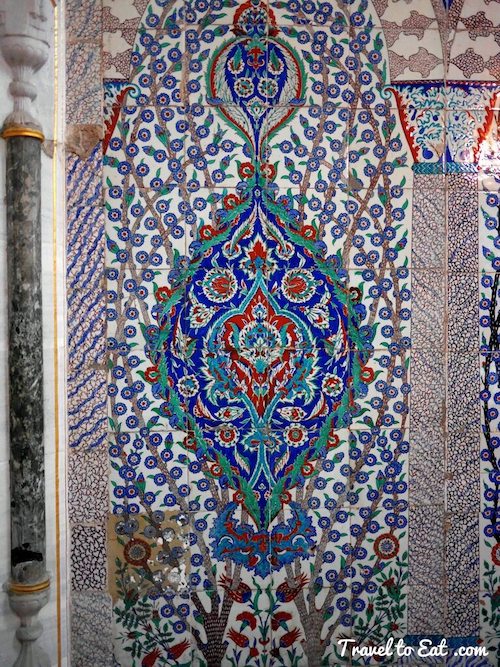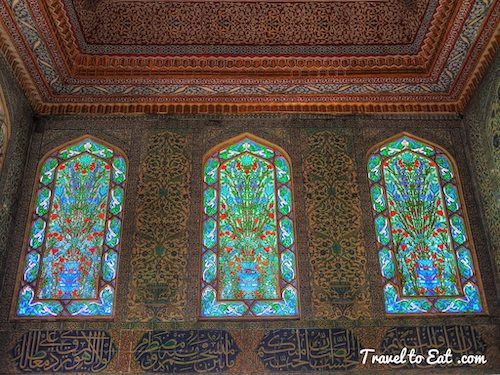
The Topkapı Palace is a huge palace in Istanbul, Turkey, that was the primary residence of the Ottoman sultans for approximately 400 years (1465–1856) of their 624-year reign. Topkapı Palace was constructed between 1460 and 1478 by Sultan Mehmed the Conqueror. The Topkapı Palace served as the home of the Ottoman sultans and their court until the middle of the 19th century. It was originally called the New Palace (Yeni Sarayı) to distinguish it from the previous residence. It received the name “Topkapı” (Cannon Gate) in the 19th century, after a (now lost) gate and shore pavilion. The complex was expanded over the centuries, with major renovations after the 1509 earthquake and the 1665 fire. After the 17th century, the Topkapı Palace gradually lost its importance as the sultans preferred to spend more time in their new palaces along the Bosphorus. In 1856, Sultan Abdül Mecid I decided to move the court to the newly built Dolmabahçe Palace, the first European-style palace in the city. Some functions, such as the imperial treasury, the library, and the mint were retained in the Topkapı Palace. Following the end of the Ottoman Empire in 1923, Topkapı Palace was transformed into a museum of the imperial era. The Topkapı Palace Museum is administered by the Ministry of Culture and Tourism. The palace complex has hundreds of rooms and chambers, but only the most important are accessible to the public today. The harem wing was only added at the end of the 16th century. Many of the rooms and features in the Harem were designed by Mimar Sinan. The harem section opens into the Second Courtyard (Divan Meydanı), which the Gate of Carriages (Arabalar Kapısı) also opens to. The structures expanded over time towards the Golden Horn side and evolved into a huge complex. The buildings added to this complex from its initial date of construction in the 15th century to the early 19th century capture the stylistic development of palace design and decoration. Parts of the harem were redecorated under the sultans Mahmud I and Osman III in an Italian-inspired Ottoman Baroque style.

The Imperial Council (Dîvân-ı Hümâyûn) building is the chamber in which the ministers of state, council ministers (Dîvân Heyeti), the Imperial Council, consisting of the Grand Vizier (Paşa Kapısı), viziers, and other leading officials of the Ottoman state, held meetings. It is also called Kubbealtı, which means “under the dome”, in reference to the dome in the council main hall. It is situated in the northwestern corner of the courtyard next to the Gate of Felicity. The entrances into the hall from outside are in the rococo style, with gilded grills to admit natural light.


The courtyard of the concubines and sultan's consorts was constructed at the same time with the courtyard of the Eunuchs in the middle of 16th century. This courtyard which underwent restoration after the 1665 fire is the smallest courtyard of the Harem. The porticoed courtyard is surrounded by baths, a laundry fountain, a laundry, dormitories and the apartments of the Sultan's chief consorts. The three independent tiled apartments with fireplaces overlooking the Golden Horn were the quarters where the consorts of the Sultan lived. These constructions covered the site of the courtyard in the late 16th century. At the entrance to the quarters of the Queen Mother, wall frescoes depicting landscapes which were executed in the late 18th century reflect the western influence. The staircase called Kirkmerdiven, the Forty Steps, leads to the Harem Hastanesi, the Hospita of the Harem, the dormitories of the concubines at the basement of the Harem, and the Harem Gardens.



For the perpetuation of the Ottoman Dynasty, beautiful and intelligent girls were brought in from neighboring countries and became became Cariyes or Concubines. The concubines who were introduced into the Harem in their tender age were brought up in the discipline of the Palace. They were promoted according to their capacities and became Kalfas and Ustas. The concubine with whom the Sultan shared his bed became a member of the dynasty and rose in rank to attain the title of Gozde, the Favourite, Kadinefendi, one of the Sultan's consorts and Valide Sultan, the Queen Mother gradually and wielded great power. The concubines lived in the halls beneath the apartments of the Consorts, Queen Mother, and the Sultan. The Kadinefendis who had borne children to the Sultan and whose number varied between 4-8 formed the group who came next in rank to the Queen Mother. Among those women who lived in their own quarters with their concubines and children, me Bas riaseki, the Favourite consort who was the mother of the crown prince and the three other Kadinefendis enjoyed a privileged position in the hierarchy of the Harem.







This section together with the apartments of the Sultan forms the largest and the most important part of the Harem. It was constructed after the Queen Mother moved into the Topkapi Palace in the late 16th century but had to be rebuilt after the fire of 1666. The section open to visitors in these apartments consisting of several spaces, is composed of two rooms; namely the Bed Room and the Prayer Room. The walls revetted with the quality products of the 17th century Ottoman tile industry are decorated with panoramic views where in the 19th century western influence is felt. On the lower stories of the apartments are the quarters of the concubines while the upper story rooms are those of the Queen Mother and her Kalfas.



The apartments of the Queen Mother are connected by a passage, leading into the Queen Mother's bathroom, to the quarters of the Sultan. The Queen Mother came to the Harem with pomp and circumstance and assumed the title of Valide Sultan. She ran the Harem and ruled over the members of the dynasty. The Valide Sultan who influenced the political life of the Ottoman Empire during various periods of history had the authority to regulate the relations between the Sultan and his wives and children. The Valide Sultan as a majestic symbol of the Ottoman Dynasty yielded great power.







The Privy Chamber of Murat III is the oldest and finest surviving room in the harem, having retained its original interior. It was a design of the master architect Sinan and dates from the 16th century. Its dome is only slightly smaller than that of the Throne Room. Its hall has one of the finest doors of the palace and leads past the wing of the crown princes (Kafes). The room is decorated with blue-and-white and coral-red İznik tiles. The rich floral designs are framed in thick orange borders of the 1570s. A band of inscriptional tiles runs around the room above the shelf and door level. The large arabesque patterns of the dome have been regilded and repainted in black and red. The large fireplace with gilded hood (ocak) stands opposite a two-tiered fountain (çeşme), skilfully decorated in coloured marble. The flow of water was meant to prevent any eavesdropping, while providing a relaxed atmosphere to the room. The two gilded baldachin beds date from the 18th century.





The Twin Kiosk / Apartments of the Crown Prince (Çifte Kasırlar / Veliahd Dairesi) consists of two privy chambers built in the 17th century, at different times. The building is connected to the palace and consists of only one story built on an elevated platform to give a better view from inside and shield views from the outside. The crown prince (Şehzadeler) lived here in seclusion; therefore, the apartments were also called kafes (cage). The crown prince and other princes were trained in the discipline of the Ottoman Harem until they reached adulthood. Afterwards, they were sent as governors to Anatolian provinces, where they were further trained in the administration of state affairs. From the beginning of the 17th century onward, the princes lived in the Harem, who started to have a voice in the palace administration. The Twin Kiosk was used as the privy chamber of the crown prince from the 18th century onward.


The Courtyard of the Favorites forms the last section of the Harem and overlooks a large pool and the Boxwood Garden (Şimşirlik Bahçesi). The courtyard was expanded in the 18th century by the addition of the Interval (Mabeyn) and Favorites (İkballer) apartments. The apartment of the Sultan's Favorite Consort along with the Golden Road (Altın Yol) and the Mabeyn section at the ground floor also included the Hall with the Mirrors. This was the space where Abül Hamid I lived with his harem. The wooden apartment is decorated in the rococo style.

Even before you get to the main door of the Topkapi harem, the sense of enclosure and secrecy begins to grow. From the main gate in the palace walls, you have to walk a good 10 minutes and pass through courtyards that were once open only to the Grand Vizier and the most prominent diplomats.These privileged visitors got only as far as the Gate of Felicity, the entrance to the third courtyard. Just inside is the domed Audience Chamber, a marble-floored pavilion with a dazzling scheme of patterned Iznik wall tiles, where they would have been received by the sultan. The entrance to the harem is hidden away to one side of the gate. Inside here, the sense of enclosure grows. You are no longer progressing through open courtyards. This is an interior, inward-looking world of green and blue tiled corridors and tiny cubicles lined with sofas; of narrow spaces and inter-linking rooms. Even though only about 20 of some 300 rooms are open to the public, it becomes impossible to retain a sense of direction. Only the occasional glimpse of distant minarets, or the glint of the Sea of Marmara, provides any hint of the outside world.
[mappress mapid=”38″]
References:
Go Turkey: http://www.goturkey.com/en/pages/content/750
Wikipedia: http://en.m.wikipedia.org/wiki/Topkap%25C4%25B1_Palace

